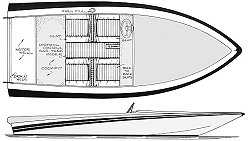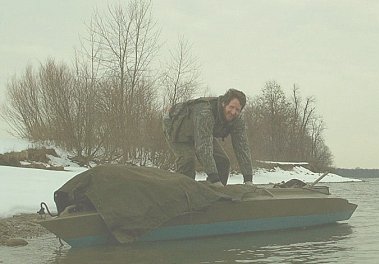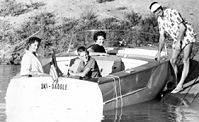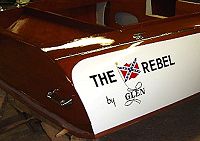

An Occasional Publication for the Home Boat Builder
Glen-L Marine Designs - 9152 Rosecrans Ave. - Bellflower, CA 90706

In this issue
- Featured design: Stiletto
- Sculling Without The Oar by Andy Brenner
- Boatbuilding or fishing... part 3 by Mike Lechowski
- Popular poplar?
- Feedback: Sculling Skiff by Don Scribner
- Shop Talk: Why Cover with Fiberglass?
- Poxy-Shield: Controlling working time
- Recent email
GLEN-L Update
- Web site:
- The big news about the Glen-L site since the last WebLetter was the "Worm" that infected the site through a security weakness in the Boatbuilder Connection software. At 07:20 on 12-21-04, all webpages on the site were changed to this page. It took almost three hours to restore the over 5000 pages on the site. It took a couple of weeks to get the new Boatbuilder Connection up and running with new software. I would hope that this never happens again, but chances are something like this will happen again. Thanks for all the messages telling us of the problem and your patience while the site was down.
- Questions about epoxy? The EPOXY SYSTEM TECHNICAL MANUAL is often overlooked. It has been on our site for years and will answer most common questions. If you would like to have a hard-copy of the Manual, it's just $2.00 post paid to anywhere in the US.
- So, I came across this site following links from somewhere and they had links to sites selling boat plans. At the end of each listing they had a "Rate" button. Rating is based on the site's content, with 5 stars being best... we had 4 stars. Ok, we don't have a shopping cart. But 4 stars? www.boatdesign.net
- This issue of the WebLetter features the Stiletto 16' ski boat. The next featured boat will be the Trawlers. If you have photos or feedback on any of the trawler designs, I hope you will share them with our readers. Our readers want answers to questions. You know what those questions are... you asked them yourself. Share what you know, there's a builder out there who will thank you for it. A reminder: This section is in response to reader requests. I will try to present as wide an array of designs as possible, attempting to add additional information from what is currently on the site, can be difficult without your input.
Editor

Featured Design: Stiletto
The 16' Stiletto was styled after the high performance SK inboards that were the rage in the early '60's. During construction of the test model, Glen took photos as Don Ruffa built the boat in the shop behind the office. Glen had hopes of getting the Stiletto into Popular Mechanics magazine. Because Glen provided written copy and photos, Glen-L designs often appeared in Popular Mechanics and special edition boatbuilding magazines, like "How to Build 20 Boats" and "Boatbuilder's Handbook". Stiletto did eventually appear in the January 1967 edition of Popular Mechanics and was an immediate "best seller".
Many of the Glen-L test models get little use, but the Stiletto was used quite a bit for skiing. Don Ruffa particularly enjoyed water skiing, and often took the Stiletto out on weekends. The sleek styling of the Stiletto meant that it always got a lot of attention and its light weight assured that it performed.
Skiing was the motivation for Allyn Perry, our current shop foreman, to build his first boat... the Stiletto. Allyn's first exposure to Glen-L was at the age of 12 when his brother built the Glen-L Swish, behind which he learned to water ski. After Allyn got married, he realized that the only way he could afford a boat was to build one as his older brother had done. Although Allyn was definitely on a budget, he did spring for ribbon-grain mahogany on the foredeck. To give it the special "Glen-L" look of the test model, Allyn applied coat after coat of varnish, carefully sanding between coats. When the final coat was applied, Allyn stood back to look at his masterpiece... and the cat jumped into the middle of the deck. Although he was undoubtedly very upset at the time, today he laughs about the incident. "I was able to fix it" he laughs as he continues to describe the antics of various cats he has had over the years. Allyn still had his Stiletto when he came to work for Glen-L as an assistant in the shop. He sold it when he became interested in hang-gliding and made his first hang-glider.
Stiletto appeared in POPULAR MECHANICS magazine in 1967. The editor asked for additional photos to include in the article, so Glen, Ken Hankinson and Bill Holman, a photographer friend, took the boat and a female model to Long Beach Marine Stadium. The idea was to put the boat in the water, shoot a few pictures with Ken in the boat, talking to the girl on the beach. The motor was hung on the boat, but not clamped tightly, since it wasn't going anywhere. Ken was very impressed with the girl and as photos were being shot Ken talked to her about whatever came to mind. When the shoot was over, they continued to talk and Ken asked the young lady if she would like to take a run around the stadium. As Ken started the motor, Glen came running toward the boat yelling and waving his arms, Ken gunned the motor... Well, the motor didn't fall completely off the boat, but it was a near thing. Recollections of this photo shoot often managed to come up in conversations when there was a crowd and Ken was present.
After other test models replaced the Stiletto, it was carried into the office where it sat for several years, until a visitor said he wanted to buy it. I remember the Stiletto very well since whenever I looked up from my desk, there it was. It was the design that I most often recommended when anyone asked about small outboad ski boats. The Stiletto has continued to be a popular design, however, it has been eclipsed in recent years by the older style runabouts that lend themselves to the "mahogany runabout" look.
If you are looking for a small, fast, reliable ski boat, there is no better choice than the Stiletto. The Stiletto is still a crowd pleaser, especially when it is given a natural mahogany deck and coaming. Check the links below to see what other builders have done with the Stiletto.
Links:
Sculling Without The Oar: Pedal drive
by Andy Brenner

This boat is one that I designed and built myself. I won't spend much time discussing the design in this article. You really need to be driven by a very particular purpose to go to all the trouble of designing your own boat. In this case I had a particular problem to solve. It has never even been used for one of its main functions... but that is another story.

I don't care what anyone says,
fiberglass boats ain't natural...
Boatbuilding or fishing...
Part 3 of a boatbuilding odysseyby Mike Lechowski
Mike has written previously about his project in WebLetters 61 and 62With the fairing finally finished, it was time for plywood.
Here I had a bit of a dilemma. My local supplier can get marine ply but it's a special order and it would be un-returnable in case there was something not right. The only other choice would be to go with standard ply and maybe do some picking. I had knocked this around for quite a bit until one day when I was in the backyard I looked at the cover to my crawl space. I had replaced it two years before and I used 3/8" AC exterior plywood and never got around to painting it. Yup it got a lot darker in two years, but that's it. Two seasons under the snow, ice cold temps outside and very humid on the inside (dryer vents right into the crawl space; I guess I will have to fix that too), rain and sun and... well after two years the ply is fine. Not even a hint of delaminating. So one fine evening - yup you guessed it - I pulled the boat off the trailer and off to Home Depot I went. My wife decided to accompany me on the trip (I think she was afraid that I will come back home with a whole set of brand new power tools) and with her help (sort of) I started to dig through the stack of plywood. The guys that work there looked at me kinda funny but, I got bunch of plywood that was the best of the stack and actually very good looking.
The next weekend I started to attach planking to the frame. Sides were easy, 1/4" ply with almost no bending, little fairing and then... the bottom. Ouch. The two pieces in the back were no problem but the front! Some soaking in hot water, some fitting, adjusting, more soaking, fitting... finally done. At this point there are a couple of things worth noting:
1. Deck screws (green ones sold by home centers everywhere) are probably the best holding screws in the world. I have used the whole bunch for pulling, bending and holding the ply in place while working on it. As a matter of fact I have decided to leave a few of them in place to see how they fair against the galvanized ones.
2. I'm beginning to dislike the screw gun... there are a LOT of screws.
3. Glue. I started with Poxy-Grip, switched to thickened Poxy-Shield and then for the last three pieces to OSI Premium Polyurethane. I read a lot of good things about it and the temptation of using glue from a tube was just too great. Besides, in my years of working in construction, I must have used a sea of OSI glue like PL400 and have never seen it fail (as long as it was applied to a dry surface). This stuff is supposed to be even better and stronger so I have flipped the coin and decided to use it.
4. Wear old clothes that you won't need much longer since the washer has problems removing set epoxy or glue.
Popular poplar?
Poplar is readily available in many parts of the US, for a good price. It is not on anyone's list of recommended boatbuilding lumbers, but we continue to get "can I use it" questions. I ran across the following at www.woodfinder.com.
Yellow Poplar
(Liriodendron tulipifera)OTHER COMMON NAMES: Tulip poplar
SPECIFIC GRAVITY: 0.4
DENSITY: TANGENTIAL
MOVEMENT: 8.20%
RADIAL MOVEMENT: 4.60%
VOLUMETRIC SHRINKAGE: 12.70%
DURABILITY: Poor
SOURCE: Eastern U.S., Appalachians and Southern states
DESCRIPTION: Fairly light in weight, fine textured, fairly soft and usually straight-grained. Enjoys a good reputation for dimensional stability. Heartwood has a greenish cast, sometimes with dark brown streaks; sapwood usually off-white.So, what does it mean? ...Poplar is not on anyone's list of recommended boatbuilding woods. Perhaps because of "poor durability".
Feedback: Sculling Skiff
by Don Scribner

Last summer, I finished the 'Sculling Skiff' using stitch and glue plywood construction. This is a picture of my son, Troy, moving through the water at a pretty good clip. The boat is so sleek that it leaves almost no wake.
The second picture was taken just before the DNR ranger showed up and asked: "Is this boat registered in Illinois?" My little plywood skiff now has a 12 digit hull identification number. Another DNR agent actually had to come to my garage to verify that it was home made. A lot of trouble for the $13 license fee.
Where we live, it is difficult to get marine-grade materials. For instance, I was only able to find one supplier that even carried 1/8" plywood, and that was interior grade*. But when it was covered in fiberglass and epoxy inside and out, it didn't really matter. The wood turned out so beautifully that I didn't need to paint the outside. The joint filler was white, so it was necessary to paint the inside bottom and up to 4" above the sheer line. I made the riggers and sliding seat from scratch, but I had to buy the oars (they cost as much as the rest of the boat combined). There were just too many curves in too many planes for me.
The main problem with the skiff is that it is scary-fast. My son and I are the only ones willing to even get into it. The oars have a 19 foot wingspan, which gives tremendous leverage. Within 4 strokes, you can be going 4-5 miles an hour. That doesn't sound like a lot, but it is twice as fast as a canoe or kayak. If you catch an oar at that speed, bad things can happen in a big hurry.
Overall I found the plans to be well thought out and understandable. I learned a lot and would do a better job if I had the chance to do it over, but next time I am going to build a sailboat.
From a design standpoint, it would help if you could lower the seat an inch or two. With the current seat arrangement, your center of gravity is pretty high for such a short and narrow boat.
I am learning to handle my little skiff and getting more confident, but this is definitely not a boat for the timid. I don't know if I will ever get to the point where I will take it out so far that I can't swim back to shore!
* Note: We would not recommend using interior plywood. Yes, if no water gets to the inner plies, it may be all right, but should water get in through a small hole or other break in the surface, the boat could turn to rubber and there is no way to fix this. ...Glen-L
Shop Talk: Why Cover A Boat With Fiberglass?
Taken from HOW TO FIBERGLASS BOATS, Chapter 2It may seem self-evident why one should want to cover a boat with fiberglass. But the surprising thing is that many people do not realize the REAL reasons. Some just assume that it's the thing to do because they've seen it done before. Others have misconceptions as to what the product can do. For example, many novices consider the fiberglass sheathing to be a "wonder" material that will cure all future ills.

Unfortunately, much of the misconception surrounding fiberglass sheathings is the result of promotional efforts and false information passed on from those with vested interests, i.e., the people who want to make a buck selling the materials. The primary reasons for covering or sheathing a boat hull with fiberglass, however, are quite basic, and are as follows: 1. Reduce hull maintenance 2. Improve appearance 3. Keep water out of the boat 4. Protect the hull from impact and abrasion. These are the REAL reasons, and any ONE of the above may be reason enough to go through the work and expense of doing the job if you think your boat is worth it. Of course, there can be secondary reasons, the importance of which will vary considerably depending on the type of boat, the waters in which it will be used, and the service to which it is put.
Poxy-Shield: Controlling working time
...the boatbuilder epoxy
Temperature
The most common questions concerning using Poxy-Shield involve working time. Whether the resin is taking too long to set up or it is setting up too quickly, the answer is most often temperature. In winter, the resin kept in the garage can get quite cold and by the time it warms up to daytime temperatures, the workday may be coming to an end. In summer, when resin temperature can be higher than ideal working temperature (around 70 degrees), the resin may be curing so quickly that you lose resin. There is a very simple solution to both of these conditions: store the resin somewhere warmer in winter and cooler in summer. If the resin starts at a reasonable working temperature, the reaction will normally start before the resin is able to adjust to the ambient temperature.
Volume
How long does the resin stay workable? There is no answer to this unless variables are established. One variable is temperature: warmer, sets up faster; cooler, sets up more slowly. At about 40 degrees the resin hibernates until the temperature rises. Another variable is volume. If I mix total volumes of resin and hardener of 1 cup and I put this amount in a cup container and an equal amount in a large pie tin, the volume in the cup will go off long before the resin in the pie tin. The reason for this is that when hardener is added to resin, a reaction starts. This reaction generates heat. In the cup container the heat does not dissipate quickly and the curing accelerates. In the pie tin, the heat escapes from the large surface area and the builder has more working time. Hardener should not be added to resin until you are ready to use it, then the mixture should be removed from the container as quickly as practical.
Other tricks... adding less hardener... more hardener? NO. Think of Poxy-Shield as a disassembled plastic. If you don't put all the same pieces together, you do not have the same plastic, and we don't know what its characteristics are. One final point: NEVER use either resin or hardener by itself. It is always mixed at a ratio of 5 parts resin to 1 part hardener. It says this on the can, but periodically we talk to builders who didn't add the hardener because the instructions referred to using "epoxy resin" and not "resin and hardener".

Recent email:
Subject: Audeen with history
Date: Thu, 06 Jan 2005- the name of the Glen-L design: Audeen
- your name: David Springer
- OPTIONAL: City/State/Country: Winters, CA
- where you are in the construction project: See below

In 1959 my father completed work on the pictured Audeen (that's me in the back shortly after her maiden launch). He did a meticulous job that I still marvel at. The deck is mahogany plywood that is routed and filled with putty to obtain a plank-like appearance. The engine is a '54 Ford V8 238 (the first OHV) with a Capital in/out/reverse and Barr Marine manifolds. Dad welded a wedge into the pan to extend the oil capacity and to keep the oil from migrating away from the pump intake while the boat is approaching plane. Engine cooling water recirculates to a small tank. Water from the intake is cycled through the tank and ejected through the manifolds and exhaust pipes. Dad built mufflers from large diameter copper tube that he squished into an oval shape. Slotted 1-1/2" copper pipe inserted into end plates provide the inlet and outlet. The 'Ski-Daddle' proved her reliability on a trip we took from Lake Roosevelt (Grand Coulee Dam) over 100 miles up the Columbia to Upper Arrow Lake in Canada in 1963. I renovated her in 1989 and we still enjoy her every summer.
David Springer
Subject: Tubby Tug Project
Date: Mon, 3 Jan 2005the name of the Glen-L design: Tubby Tug
your name: Pat Morrisey
City/State/Country: Foster City, CA, USA
and where you are in the construction project: 1-3-2005 I have just begun. I have purchased materials - Frame, plans, fasteners and fiberglass kit from Glen-L. "Found wood" from my shop. I have the bottom laid out on sawhorses and have constructed a 4' x 8' sheet of carbon paper for tracing. It is humble, but a beginning. I have been successful in winning bids for a 7" Brass Ships Bell and an 18" Ships Wheel on eBay. There is no turning back now.
Below is the result of your feedback form. It was submitted on Wednesday, January 5, 2005
----------------------------------------------------------------name: Steve McClain
Comments: I built Tiny Titan in 1965 with my dad. Glen L 10 in 1974 and Sherwood Queen with an inboard Yanmar 8 horse engine, launched 2000. Currently stitching the Fife.
Below is the result of your feedback form. It was submitted on Monday, January 3, 2005
------------------------------------------------------------------name: dan zappitelli
Comments: I love your boat catalog. I purchased it 6 years ago and it got me, my sons & friends hooked. Only trouble... we can't make up our minds on what we want to build. I built Tubby Tug in the past. I belonged to a boat club and everyone was impressed. I own a 1973 Chris Craft cabin cruiser, and to tell the truth we had more fun with the Tubby than we did with our big boats. I sold Tubby and it was a big mistake. We used to take trips up the Conneaut creek, from our boat club. It was "great".
Subject: Early 1960's Rebel
Sent: Monday, December 20, 2004
From: Dave TilleyI am currently restoring an early 1960's Rebel. I acquired this boat from the original builder and would like to finish like the test boat in your catalogue. Is there anyway I can get a good detailed picture of the design painted on the rear plank?
Thanks
=========================
Dave TilleyFrom: Barry Witt
To: Dave Tilley
Sent: Monday, December 20, 2004
Subject: Re: Early 1960's RebelSee attached.
=============================
If you'd like to write something about your project, I'd be glad to put it in a WebLetter.
--
BarrySubject: Re: Early 1960's Rebel
Date: Thu, 23 Dec 2004
From: Dave TilleyThanks Barry. I'll write something up this summer after the boat is complete and in the water.
I found the boat at the back of my restorer's yard with her bow sticking out (see pictures attached) and the bottom full of holes (something about plywood vs rocks). She was built in the early 60's by the gentleman (now in his 80's) from whom I bought her. I stored her for two years until the time became available for restoration this year. She now has a new bottom and paint/finish and upholstery is underway. I found a mid 60's Mercury 650 for her on eBay.
Here's hoping everything comes together.
Thanks
=================
Dave
From: Dave Tilley
Subject: My Rebel
Date: Fri, 31 Dec 2004I thought you might like to see this. Thanks Dave
Below is the result of your feedback form. It was submitted on Saturday, January 1, 2005
----------------------------------------------------------------name: Larry "Rehd" Brown
Comments: Have enjoyed your site for several years. Helped build an '8'Ball for my brother and recently finished a Rob-Roy canoe. Have not had the opportunity to use it as yet, due to bad weather and work hours, but will get it wet at the first opportunity. Will be submitting pictures from that to my article in your Project Registry and Customer Photo sections. Thanks again for the great site... Look forward to your newsletters.
Rehd Brown
PS I was introduced to this website through your catalog, which my dad kept around, dreaming of that big fishing boat he'd build one day.
From: Mike Davis Sr.
Subject: RE: Glen-L Plans Order
Date: Wed, 15 Dec 2004Glen-L,
Thank you for the timely response. I took delivery of a Glen-L 14 that is in serious need of some competent TLC. It was built by a high school wood shop teacher in 1984, purchased from him by a plastic-boat sailor in 2000, a kind man who had no knowledge or experience of the tender care and caressing required by a beautiful wooden lady such as this. The poor beauty languished exposed to the harsh elements of Tacoma, WA for three years.
Due to my tender passion for beauties such as the 1930's vintage Sam Rabl designed Picaroon that I recently rescued from becoming firewood, and lovingly restored, I couldn't resist the temptation to take on this sweet little lady.
I'll be replacing some of the decking and some of the trim, all mahogany of course. Stripping all of the finishes, and putting a finish on her like a grand piano.
I may be asking for some additional information and materials if I run into a snag. Thanks, Michael E. Davis Sr.
===============From: Barry Witt
Sent: Monday, December 20, 2004
To: Mike Davis Sr.
Subject: Re: Glen-L Plans OrderYou are welcome to ask questions. Would be happy to post photos of your project and any comments you may have... before, during and after.
=========================
--
BarryFrom: Mike Davis Sr.
Thanks Barry,
Date: Tue, 21 Dec 2004This project is one of coincidence, if you believe that there are coincidences. I have the Glen-L plan catalog, and several other plan catalogs, that I was reviewing in consideration of a sailboat building project. I have restored an old wood sailboat (1930's vintage Rabl Picaroon), I'm a finish carpenter and painter by profession, before I stepped-down into management. Boats give me a new challenge with the compound angles and arcs to cut and fit, and a welcome relief from the stresses of management. I had decided to build either a Glen-L 14 or a Devlin "Nancy's China-15" for a first project, and then move up to a larger trailer-able cruiser for a second project. Only wood, of course.
When I was in Tacoma, WA on business, I ran into another sailor at a marina that I was visiting. He was struggling to raise the mast on a "Clorox-bottle" 24', I offered to help, ended up helping set and tune all the rigging, and then launch it. True to addicted sailors, we became fast friends with our banter and stories of sailing, the sea, boats, our women or absence thereof, children, grandchildren, dogs, cats, good beer & brandy, etc, normal sailor-talk.
During our sailor-talk he asked if I knew anyone who would be interested in a used Glen-L 14; fir frames and fiber-glassed fir-plywood hull, otherwise all mahogany. He said that he had it for about 4-years, it had been built by a high school shop teacher who he bought it from (it was originally registered in 1984), tried to varnish it and made a mess out of it, and that he would give it away to the first taker. I said "I'll be back in 2-weeks to get it", and I was true to my word.
She's now in "Woody-Michael's" (me) boat-barn, undergoing major surgery. The decking is 1/4" mahogany plywood, and it's trashed. I plan to replace the decking with 3/8" or 7/16" mahogany marine plywood, the 1/4" plywood is a bit flimsy. I have removed all of the mahogany trim-work, seats, rub-rails, etc, for refinishing. Sails and rigging look like they've never been used.
I'm quite impressed with the service I have received from Glen-L, hope this will be the beginning of a long and beautiful relationship between our companies. I'll send you some pictures later today, for your review and viewing pleasure.
YFS
Michael E. Davis Sr.
Cheshire, Or
Subject: DRAGONFLY
Date: Thu, 30 Dec 2004Just read the most recent newsletter and would like to comment on the Dragonfly design. I live on the Texas gulf coast and although there are many miles of flats, there are also inlets to the gulf itself as well. For me, the Dragonfly strikes an ideal balance. With a shallow draft, good freeboard, open deck, and an adequate load carrying capability. Combine those features with stitch and glue simplicity and you have a craft that is definitely on my short list of possibilities. Please consider larger designs using the stitch and glue method. Keep up the great work!
Jeff Borders
Subject: Glen-L Tornado on Ebay - FROM YOUR CATALOG PHOTOS!
Barry, I’m always on the lookout for a great flat bottom v-drive deal, but I was really surprised to see the “original” Tornado show up on Ebay. If it’s not the same boat, “Hand Job”, that’s been used in your catalog for a couple of decades, it’s painted, named, rigged and trailered just like the catalog photo. Here’s the link to the auction site: photos. The auction closes in 12 hours or so (it ends at 8:43AM PST on 12/22); you should still be able to link to it after the auction closes. Thought you’d be interested. There may be some history on it available.
Date: Tue, 21 Dec 2004
Paul Miller
Germantown, TN
Winning bid: US $4,870.00
Ended: Dec-22-04 08:43:11 PST
Subject: Ray Moran
Date: Mon, 20 Dec 2004Hello Barry,
Just a note to let you know that Ray Moran's "Miss Mist" was at it again this fine, December 19th, 2004 Sunday in LA Harbor.
We toured the harbor at 5 knots and then took her out in the outside harbor where we could cruise on plane.
We are running a potent 327 Chevy through a transmission turning a 12" X 17" stainless OJ prop. The boat still fly's! Recall we keep her in the harbor, she is 3/4" thick laminations of shop plywood held together with West systems epoxy and fiberglassed.
We only make short 1/8th mile "blasts", but she fly's nicely on the prop. We suspect your recommended six cylinder would be the best power plant. There is nothing like listening to that Chevy V-8 cam lope through those 3" exhaust though!
Ray is 83 and loved every minute of it, as did I.
Thanks for keeping the wood boats alive.
Mike Freige
Build more boats
GLEN-L boats, of course

